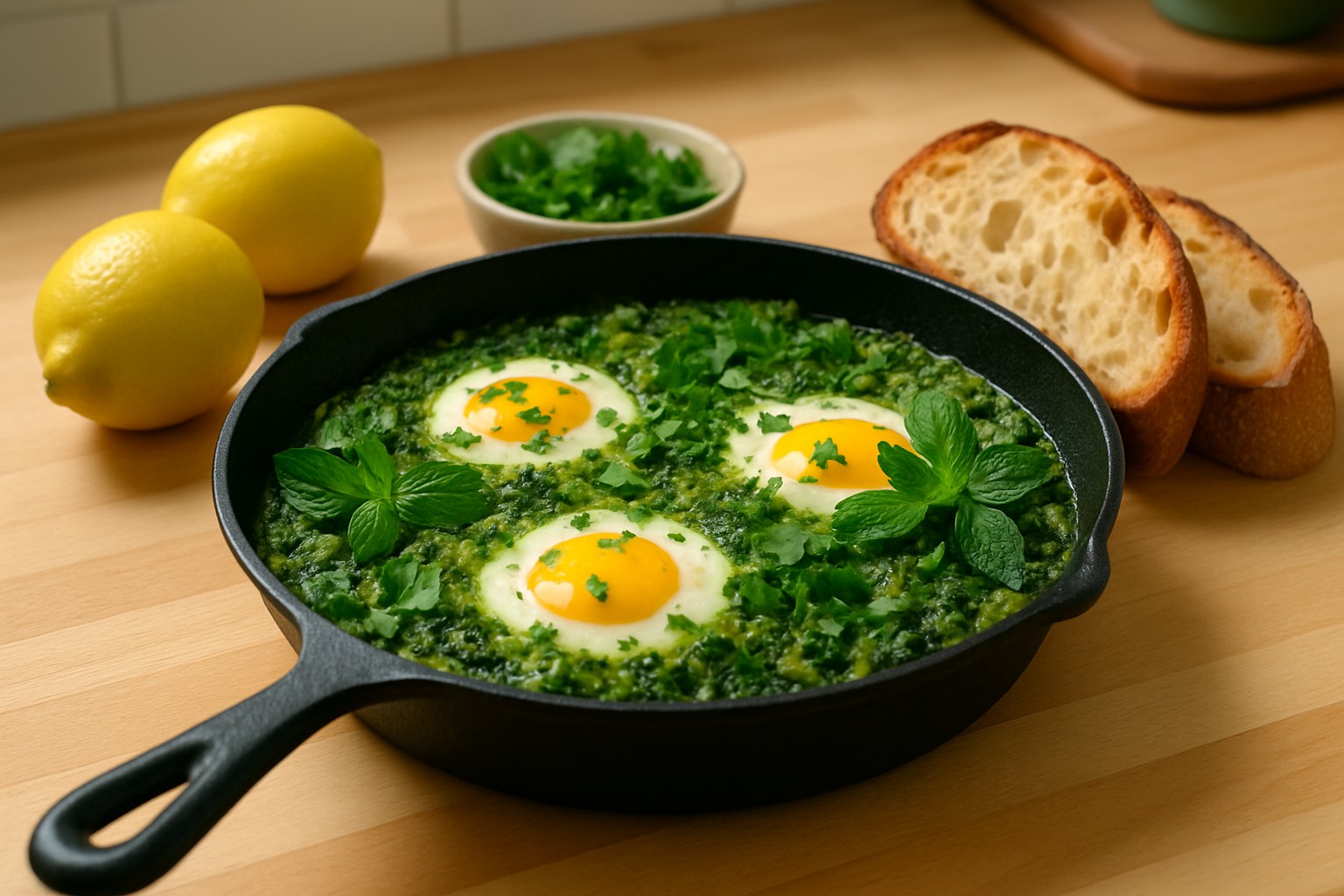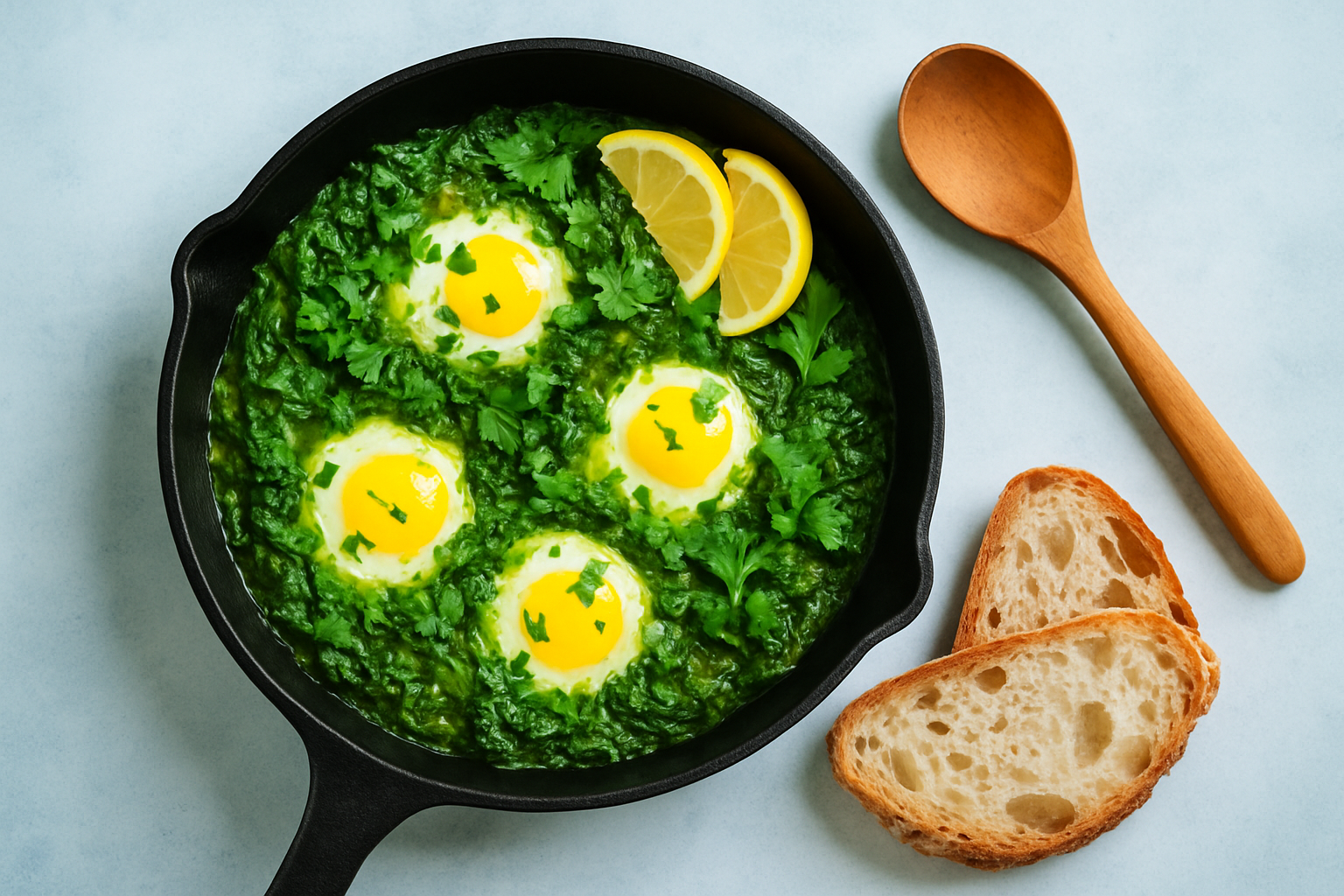How To Make Green Shakshuka With Fresh Herbs

Green shakshuka brings a bright fresh twist to the classic Middle Eastern breakfast staple. Rather than the usual spicy tomato base this version bursts with a fragrant herb-packed sauce loaded with fresh greens and herbs.
Shakshuka has its roots in North Africa but soon won hearts across the Middle East. At its core it’s all about poached eggs nestled in a spiced simmering tomato sauce that just hits the spot. Then there’s the green shakshuka variation which gives the classic a lively twist by adding a fresh mix of green veggies and herbs—think of it as the garden’s way of saying hello.
What You’ll Need to Whip Up Some Green Shakshuka
Making green shakshuka starts with a cozy mix of soft greens like spinach or kale joined by fresh herbs such as parsley, cilantro and a hint of mint that wakes things up nicely. Aromatics like garlic and onions bring their signature charm while warming spices like cumin and a touch of green chili add just enough heat to keep things interesting without stealing the show. Fresh eggs add a lovely creaminess that brings everything together and a bright squeeze of lemon juice cuts through with the right zing.
| Ingredient | Quantity | Substitute Options | Notes on Freshness/Preparation Tips |
|---|---|---|---|
| Fresh spinach | 4 cups loosely packed | Kale or Swiss chard | Young leaves are usually more tender; give them a good wash to avoid any surprises |
| Fresh parsley | 1 cup chopped | Cilantro or basil | Look for bright, firm leaves to get that fresh, punchy aroma |
| Fresh mint | 1/4 cup chopped | Omit or swap with basil | Mint adds a lovely fresh twist; just a pinch keeps it from taking over the show |
| Onion | 1 medium, finely chopped | Shallots | Yellow or white onion brings a richer flavor to the party |
| Garlic | 3 cloves, minced | Garlic powder (1 tsp) | Fresh garlic usually packs a stronger, more vibrant punch, in my experience |
| Green chili | 1 small, chopped | Jalape\u00f1o or omit for mild version | Tailor the heat to your liking—spice is no one-size-fits-all |
| Cumin | 1 tsp ground | Coriander or smoked paprika | Toasting the spice first really unlocks deeper, nuttier flavors |
| Eggs | 4 large | Egg whites (for lighter option) | For the best poached eggs, fresh ones at room temperature work wonders |
| Olive oil | 2 tbsp | Avocado oil | Extra virgin olive oil delivers the most authentic, fruity flavor |
| Lemon juice | 1 tbsp fresh | Lime juice | A splash adds brightness and balances out those greens |
| Salt | To taste | Sea salt does a lovely job of bringing out the natural flavors | |
| Black pepper | To taste | White pepper | Freshly ground black pepper usually takes the flavor up a notch |
Key Tools and Equipment You’ll Absolutely Need (No Ifs, Ands, or Buts)
- A trusty non-stick skillet or a well-seasoned cast iron pan that spreads heat evenly and makes poaching eggs a breeze
- A wooden spoon perfect for gently stirring greens without turning them into mush because nobody likes sad bruised veggies
- A sturdy cutting board that’s up for the task and gives you a safe solid spot to chop herbs and veggies with confidence
- A sharp knife that slices through delicate herbs and greens like a hot knife through butter, making your prep work smoother and more precise
- Measuring spoons and cups to keep your seasonings and ingredients in harmony because a pinch here and a dash there can make or break the dish
- A lid for your pan that is key for steaming and poaching eggs just right, locking in all the good moisture
- A small bowl to crack your eggs into first, letting you slide them gently into the pan without sneaky shells crashing the party
Choosing the right tools really sets the stage for green shakshuka to cook evenly and keeps that vibrant texture just right. If you don’t happen to have a cast iron pan lying around, a heavy-bottomed skillet usually steps up to the plate nicely. Sharp knives make prep not only safer but also a lot less of a hassle. Having a lid is key for gently steaming the eggs to perfection.
A Friendly, No-Fuss Guide to Whipping Up Green Shakshuka
Give your fresh herbs and greens a good rinse—they might be a bit dirty from the garden. Then roughly chop the spinach, parsley and mint. There is no need to be perfect here because rustic is the charm.
Warm up some olive oil in a skillet over medium heat. Toss in the chopped onion and garlic and cook them until they soften and release that mouthwatering aroma. This usually takes about 3 to 4 minutes.
Stir in the chopped green chili and spices like cumin. Let them toast gently to wake up their fragrance without burning. Think of it as a little aromatherapy for your kitchen.
Add those chopped greens to the pan and cook until they’re wilted and tender but still holding onto their bright color. This usually takes around 3 to 5 minutes. Don’t forget to season with salt and pepper because it really brings everything together.
If it starts to look a little dry, add a splash of water or broth to keep things moist. Then crack the eggs evenly over the greens. Cover the pan and cook for 5 to 7 minutes depending on how you like your eggs.
Once the eggs are cooked to your liking, drizzle some fresh lemon juice over the top and sprinkle on a handful of extra chopped herbs. Serve it straight from the pan for that homey no-fuss vibe.
Timing really does play a starring role when it comes to making green shakshuka. You want the garlic and onions to soften up nicely without getting a hint of brown—no one wants that bitterness sneaking in. The greens? Just wilt them enough to hold on to their bright color and those precious nutrients. As for the eggs, poaching them so the yolks remain runny brings a lovely richness that ties everything together.

Finished green shakshuka served in a skillet, garnished with fresh herbs and lemon, ready to eat
Helpful Tips for Making the Perfect Green Shakshuka (Yes, It’s Possible!)
- To keep those eggs from turning rubbery cover them up and cook gently on low heat. Check the yolks now and then to see how they are doing.
- Balance your herbs by pairing milder ones like parsley with the stronger flavor of cilantro. Think of it as a flavor tug-of-war where everyone wins.
- Add some greens like Swiss chard or kale. They provide a nice texture contrast and sneak in extra nutrition.
- Fresh herbs work great while cooking but to make the flavor really pop sprinkle dried herbs into the sauce. It is like turning up the volume.
- Serve your dish with warm crusty bread or homemade flatbread to soak up every last drop of sauce.
- Control the heat by adjusting how much or which type of green chili you add. Managing spice is more an art than a science.
- A dollop of Greek yogurt or labneh adds a creamy touch and a gentle tang that pulls everything together beautifully.
A common snag is watery sauce because the greens decide to let loose with too much liquid. Cooking them well and draining any extra moisture beforehand usually does the trick. If the eggs break or stick, make sure the pan is nicely oiled and resist the urge to stir once they hit the heat. For uneven cooking, lower the heat and be patient
How to Serve and Store Green Shakshuka (Because Leaving It Out Is a No-Go)
Green shakshuka truly shines when paired with something crusty like bread or pita or naan—perfect for scooping up that luscious sauce and those perfectly cooked eggs. It pairs effortlessly with fresh salads, creamy labneh or some roasted veggies.
Keep those delicious leftovers fresh by popping the green shakshuka into an airtight container and stashing it in the fridge for up to 3 days. When you’re ready to reheat, take it easy. Warm it gently on the stove or in the microwave and be sure to cover it to lock in the moisture. As for fresh herbs, I have found they stay happiest when wrapped snugly in a damp paper towel inside a resealable bag in the fridge.
Frequently Asked Questions
Can I use frozen greens instead of fresh for green shakshuka?
Absolutely, frozen spinach or kale can step in when fresh isn’t on hand. Just be sure to thaw and drain any extra liquid first because nobody wants a watery sauce stealing the show. Fresh greens usually bring a brighter flavor and more texture to the party but frozen is a trusty backup. Just keep in mind they wilt quicker so you’ll want to keep an eye on cooking time and adjust as needed.
How do I know when the eggs are perfectly poached in green shakshuka?
You’re aiming for whites that are set and yolks still slightly runny. That sweet spot usually takes about 5 to 7 minutes on low heat with the pan covered. If you’re after firmer yolks just let them go a minute or two longer. A little pan shake helps too. If the yolks wobble like jelly but the whites aren’t see-through you’re golden.
What’s the best way to reheat leftover green shakshuka without overcooking the eggs?
Easy does it here. Warm it gently on the stove over low heat with a splash of water or broth and cover the pan to trap steam which keeps things moist. Alternatively the microwave works fine if you heat in short bursts and stir gently in between. Just a heads-up: the eggs will firm up a bit so it’s best to stop reheating as soon as everything’s warmed through to keep that lovely texture.
Can I make green shakshuka without eggs for a vegan version?
Definitely! Swap in cubed tofu or chickpeas wherever you’d normally crack eggs. That way you keep the heartiness without missing a beat. For an extra creamy vibe try stirring in some coconut milk or cashew cream. The sauce is herb-packed and flavorful enough that you can tweak the spices confidently to suit your taste.
Why is my green shakshuka sauce too watery? How can I fix it?
Too much liquid usually means the greens weren’t drained well or they got a quick sauté that was rushed. Try cooking the greens a bit longer so extra moisture can evaporate. You can also toss in a spoonful of flour or tomato paste to thicken things up nicely. Serving it straight away helps because leftovers tend to release more liquid when reheated like the sauce trying to sneak away.
What are the best herbs to use if I don’t have cilantro or mint?
Dill, basil or tarragon make fantastic stand-ins. Parsley is a great mild base and then you can add smaller amounts of those stronger herbs for balance. If you’re reaching for dried herbs like oregano go easy and use about half the amount because their flavors tend to punch harder.





